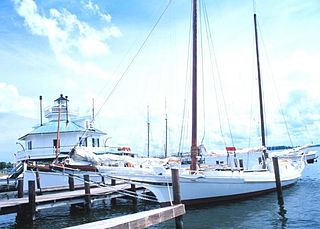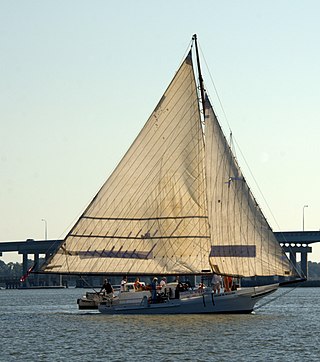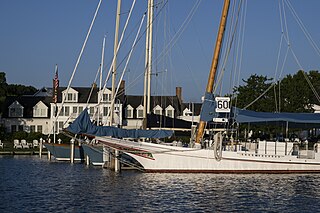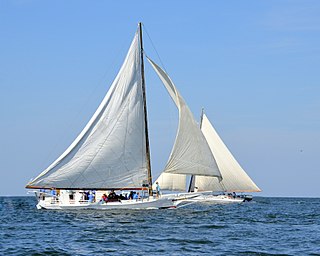
The skipjack is a traditional fishing boat used on the Chesapeake Bay for oyster dredging. It is a sailboat which succeeded the bugeye as the chief oystering boat on the bay, and it remains in service due to laws restricting the use of powerboats in the Maryland state oyster fishery.

A fractional rig on a sailing vessel consists of a foresail, such as a jib or genoa sail, that does not reach all the way to the top of the mast.

The log canoe is a type of sailboat developed in the Chesapeake Bay region. Based on the dugout, it was the principal traditional fishing boat of the bay until superseded by the bugeye and the skipjack. However, it is most famous as a racing sailboat, and races continue to be held.

The bugeye is a type of sailboat developed in the Chesapeake Bay for oyster dredging. The predecessor of the skipjack, it was superseded by the latter as oyster harvests dropped.

Hilda M. Willing is a relatively small Chesapeake Bay skipjack, built in 1905 at Oriole, Maryland, and declared a National Historic Landmark in 1994.

The Edna E. Lockwood is a Chesapeake Bay bugeye, the last working oyster boat of her kind. She is located at the Chesapeake Bay Maritime Museum in Saint Michaels, Maryland. She was built in 1889 at Tilghman Island, Maryland by John B. Harrison and is of nine-log construction, similar to the smaller log canoe, and was launched on October 5, 1889 for Daniel Haddaway, at a cost of $2,200. She worked for at least seven sets of owners from 1899 until 1967, and was then sailed as a yacht until donated to the museum in 1973. The museum undertook an extensive restoration of the Lockwood from 1975 through 1979, which restored the bugeye to its 1910 appearance with the "patent stern" that had been added sometime prior to that year. She is the last bugeye retaining the sailing rig and working appearance of the type. Her length is 53.5 feet (16.3 m), with a 15.25 feet (4.65 m) beam and a draft of 2.58 feet (0.79 m) with the centerboard up, and a maximum sail area of approximately 1700 square feet.

The Kathryn, a Chesapeake Bay skipjack, was built at Crisfield, Maryland in 1901. Ported at Chance, Maryland, she is reputedly one of the fastest skipjacks on the Bay. She was designated a National Historic Landmark on April 19, 1994. She is one a small number of older skipjacks to survive in working condition.

The William B. Tennison is a Chesapeake Bay bugeye built in 1899 and converted to an oyster buy-boat in 1906–07. With the conversion her sail rig was removed and an engine inserted, and is the only surviving example of this conversion. Her construction marks a transition between log construction and plank construction. She is homeported at the Calvert Marine Museum in Solomons, Maryland. The Tennison is reputed to be the second oldest licensed passenger vessel in the United States.

The Nellie Crockett is a Chesapeake Bay oyster buy-boat built for Andrew A. Crockett of Tangier, Virginia, in 1925. She is located at Georgetown, Maryland, USA. She was designated a National Historic Landmark in 1994.

E.C. Collier is a Chesapeake Bay skipjack, built in 1910 at Deal Island, Maryland. She is a 52-foot-long (16 m) two-sail bateau, or "V"-bottomed deadrise type of centerboard sloop. She has a beam of 17.9 feet (5.5 m), a depth of 4.5 feet (1.4 m), and a registered net tonnage of 14 tons. She is one of the 35 surviving traditional Chesapeake Bay skipjacks and a member of the last commercial sailing fleet in the United States. At the time of her documentation on the National Register of Historic Places she was located at Tilghman, Talbot County, Maryland. She is now a permanent exhibit at the Chesapeake Bay Maritime Museum in Saint Michaels, Maryland.

The Maggie Lee is a Chesapeake Bay skipjack, built in 1903 at Pocomoke City, Maryland. She is a 51' long two-sail bateau, or "V"-bottomed deadrise type of centerboard sloop. She has a beam of 16', a depth of 3.8', and a net tonnage of 8 register tons. She is one of the 35 surviving traditional Chesapeake Bay skipjacks and a member of the last commercial sailing fleet in the United States. She is located at Denton, Caroline County, Maryland.

The Minnie V is a Chesapeake Bay skipjack, built in 1906 at Wenona, Maryland, United States. It is a 45.3-foot-long, two-sail bateau, or "V"-bottomed deadrise type of centerboard sloop. It has a beam of 15.7 feet and a depth of 3 feet with a net registered tonnage of 8 tons. It is one of the 35 surviving traditional Chesapeake Bay skipjacks and a member of the last commercial sailing fleet in the United States. It is located at Tilghman, Talbot County, Maryland.
The Nellie L. Byrd is a Chesapeake Bay skipjack, built in 1911 at Oriole, Maryland. She is a 53.6' long two-sail bateau, or "V"-bottomed deadrise type of centerboard sloop. She has a beam of 26.7', a depth of 4.8', and a net tonnage of 18 tons. She is one of the 35 surviving traditional Chesapeake Bay skipjacks and a member of the last commercial sailing fleet in the United States. When listed, she was located at Tilghman, Talbot County, Maryland. Since 2005, she is located at Middle River, Maryland, Baltimore County, Maryland.

The Stanley Norman is a Chesapeake Bay skipjack, built in 1902 by Otis Lloyd, Salisbury, Maryland. She is a 48-foot-3-inch-long (14.71 m) in Length overall with length on deck (LOD) OF 47.5-foot-long (14.5 m) two-sail bateau, or "V"-bottomed deadrise type of centerboard sloop. She has a beam of 16 feet (4.9 m), a depth of 4 feet (1.2 m) at the stern with the centerboard up, and a registered tonnage of 7 tons.

The Elsworth is a Chesapeake Bay skipjack, built in 1901 at Hudson, Maryland. She is a 39.9-foot-long (12.2 m) two-sail bateau, or "V"-bottomed deadrise type of centerboard sloop. She has a beam of 14.3', a depth of 3.1', and a gross registered tonnage of 8 tons. She is one of the 35 surviving traditional Chesapeake Bay skipjacks and a member of the last commercial sailing fleet in the United States.
The F. C. Lewis Jr. is a Chesapeake Bay skipjack, built in 1907 at Hopkins, Virginia. She is a 39-foot-long (12 m) two-sail bateau, or "V"-bottomed deadrise type of centerboard sloop. She has a beam of 14.6 feet (4.5 m) and a register depth of 3 feet (0.91 m); her register tonnage is 6. Likewise, she is one of the 35 surviving traditional Chesapeake Bay skipjacks and a member of the last commercial sailing fleet in the United States. She is located at Wenona, Somerset County, Maryland.

The Fannie L. Daugherty is a Chesapeake Bay skipjack, built in 1904 at Crisfield, Maryland. She is a 41.3-foot-long (12.6 m) two-sail bateau, or "V"-bottomed deadrise type of centerboard sloop. She is built by cross-planked construction methods and has a beam of 8 feet (2.4 m) and a depth of 3.6 feet (1.1 m). She one of the 35 surviving traditional Chesapeake Bay skipjacks and a member of the last commercial sailing fleet in the United States. She is located at Wenona, Somerset County, Maryland.

The Ida May is a Chesapeake Bay skipjack, built in 1906 at Urbanna or Deep Creek, Virginia. She is a 42.2-foot-long (12.9 m), two-sail bateau, or "V"-bottomed deadrise type of centerboard sloop. She has a beam of 14.4 feet (4.4 m), a depth of 3.3 feet (1 m), and a net register tonnage of 7. She is one of the 35 surviving traditional Chesapeake Bay skipjacks and a member of the last commercial sailing fleet in the United States. She is located at Chance, Somerset County, Maryland.
The Helen Virginia is a Skipjack boat built in Crisfield, Maryland in 1948. Having fallen into disrepair after decades of use, she underwent restoration beginning in 2013 in Chance, Maryland. The work was completed just in time to enter the 55th Annual Deal Island Skipjack Race, where maritime history was made on Sep 1, 2014 as the first-ever all-female skipjack crew, captained by Katarina Ennerfelt, sailed her to victory.
The Menger Oysterman 23 is an American trailerable skipjack that was designed by Bill Menger as a daysailer and cruiser and first built in 1977.



















